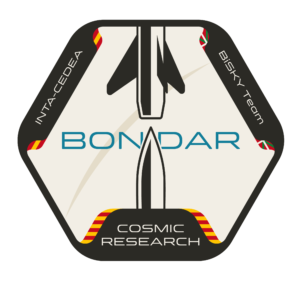About Mission Bondar
Mission Bondar aims to launch a rocket into the stratosphere (+9 km) to demonstrate the technologies involved in the launch: the rocket and its ground systems. This mission was developed by Cosmic Research with the collaboration of INTA (Spain’s Institute for Aerospace Technology) and BiSKY Team (the Basque Country University’s rocketry team). Bondar is the most complex mission ever developed by Spanish students to date and will help us pave the way for future commercialy-usable vehicles. The rocket was launched from El Arenosillo Test Centre the 30th November 2021.
The Rocket
ROCKET LENGTH
OUTER DIAMETER
LIFT-OFF WEIGHT
MAX ACCELERATION
ESTIMATED APOGEE
ONE-WAY RADIOLINK
Propulsion
Bondar is propelled by the second most powerful amateur solid rocket motor in the market: the Cesaroni 21062O3400-P. Packing 10.9 kg of propellant and 21 kN·s of total impulse, it pushed Bondar for 6 intense seconds. Before choosing a commercial motor, Cosmic Research experimented with Al-AN experimental rockets but eventually opted for a COTS motor to maximize safety.
Structures & Recovery
The rocket is built in three independent modules joined together. From left to right, these are: the motor module, the recovery module and the avionics and payload module. The structure is a monocoque type mostly made by aerospace-grade aluminum alloys. The recovery module contains two parachutes attached to the avionics module. When the rocket reaches its apogee, a CO2-based separation device is triggered. The motor and recovery modules are discarded into the sea, while the avionics and payload module is recovered.
Aerodynamics
Bondar is a passively-stabilized rocket with four static, non-canted fins. The two main goals behind the aerodynamic design are to minimize the total drag of the vehicle and keep it stable during the lift-off and the powered flight. To do so, we have used our homebuilt flight simulator together with Missile DATCOM and ASTOS to ensure that the rocket design is both optimal and safe.
Avionics & Payload
Bondar’s onboard avionics performs four basic functions: obtains and processes flight data from sensors, stores it, sends it through a 2.4-GHz wireless link and activates the modules separation device. This subsystem has been almost entirely designed and built by 2 members of BiSKY Team, from the Basque Country University.
Additionally, this rocket has the capacity to contain a 0.5 kg payload at the ogive. The payload can be any experiment that requires hyper and microgravity conditions.
Launchpad
Cosmic Research’s launchpad is currently the heaviest operational civil rocket launchpad in Spain. It was designed to withstand Bondar launch and has already enabled 12 high-power rocket launches.
The structure has a height of 6.7 meters when the tower is lifted completely, weights around 248 kg and has a declared rocket weight capability of up to 50 kg. The tower has a modular design and can be shortened if needed. It can also be inclined to match various elevation angles (75º, 80º, 85º and 90º). The launchpad can operate both anchored to the ground and unanchored in a terrain with an up to 8º ramp. The base is built in construction steel alloys while the tower uses aluminum parts.
Ground Station & Monitoring Centre
The ground station encompasses all the ground-based avionics systems arranged to receive the telemetry from the rocket. All its components are placed in the optronic system provided by INTA.
The monitoring centre takes care of the final processing and visualization of all relevant flight data. This data is shown in a machine-user interface developed by BiSKY Team. The interface is presented across Mission Control and to the Test Conductor – all green lights means GO for launch!






